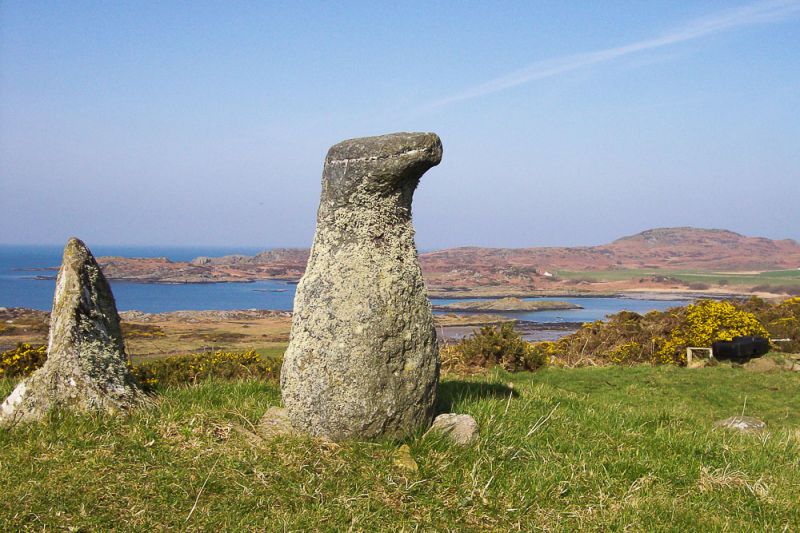Standing Stones on Gigha

Kinererach - The oldest monolith in Gigha today is probably that which stands forgotten near the farmhouse of Kinererach to the north of the island. It rises on the edge of the original road, where it is almost invisible in the field in which the farmhouse stands. Little remains but a stump. It has been reduced to a height of five feet, with a width of three feet and is somewhat oval in section; but the stump itself is broken, so that the shape is now rather that of a low seat with a back.
Carragh an Tairbeirt - On the east side of the road heading north, about 200 yards north east of Tarbert Farmhouse, on the narrow isthmus between the two bays, can be found The Stone of Tarbert - Carragh an Tairbeirt, or locally known as the "Giants Tooth". It is 71/2 feet high, 34 inches across, 15 inches thick at the north edge and 9 inches at the south. The head of the stone is curiously shaped like a mittened hand held upright with the thumb slightly apart. It is not known the exact reason why this Standing Stone was originally erected, although there has been much speculation.
Tarbert - Just to the south of Tarbert (this names appears throughout the West of Scotland and means neck of land, over which to drag a boat), lies the site of another ancient 'chapel' with the battered remains of a standing cross to mark it. Fifty yards from it is the Holy Stone, bearing primitive cross-like and other incised markings. The theory is that it is pagan in origin, but became a preaching stone in later Christian times.
Bodach and Cailleach - Cnoc a'Bhodaich (Hill of the Old Man). Between Achamore and Leim (at the southern tip of Gigha), two curious stones crown the slight remains of a fortification: the Bodach and Cailleach. They were regarded in the old days as having mysterious powers and represented the old man and the 'hag', terrifying creatures who 'walk the heath at night'.
Hanging Stone - Beside the road a little further on is a landmark, known variously as The Druid Stone, Clach a' Thairbeirt and The Hanging Stone. The name, The Hanging Stone, came from a tradition that people who were found guilty at 'The Court Hill' nearby, had their heads positioned in the cleft of the stone and were then left to hang to their deaths.
Ogham Stone - Situated just west of the ruins of Kilchattan Church, is the Cnoc A'Charraidh (Hill of the Pillar) on which stands the inscribed Ogham Stone. This pillar is square in section, standing five feet nine inches from the ground and measuring 3 feet 9 inches in circumference at the foot. Throughout the years it has received a fair amount of knocks, and the weathering on the exposed side has made it difficult to get a perfect transcription of the original sculpturing. However Professor R A S Macalister has given the reading as 'VICULA MAQ COMGINI' - FIACAL SON OF COEMGEN - and holds the opinion that it is a Scottish inscription cut under Pictish influence. Although there are other suggestions as to the meaning of the words, it is a gravestone with the conventional type of inscription giving the name of the deceased and that of his father, and probably dates from the earliest settlements of the Scots in Dalriada.